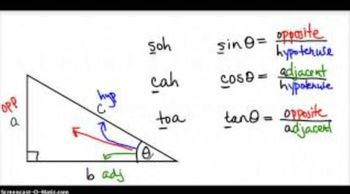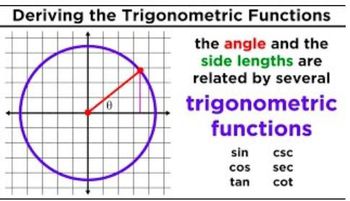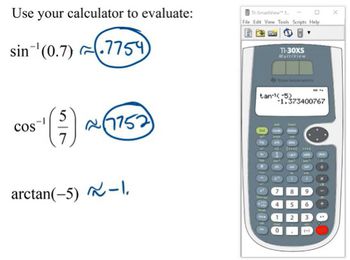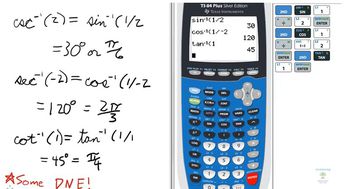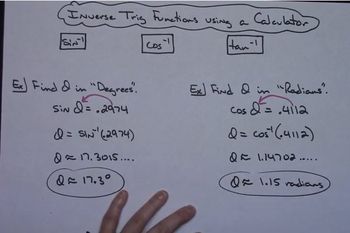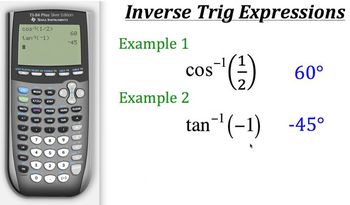Table of contents
- 0. Review of College Algebra4h 43m
- 1. Measuring Angles39m
- 2. Trigonometric Functions on Right Triangles2h 5m
- 3. Unit Circle1h 19m
- 4. Graphing Trigonometric Functions1h 19m
- 5. Inverse Trigonometric Functions and Basic Trigonometric Equations1h 41m
- 6. Trigonometric Identities and More Equations2h 34m
- 7. Non-Right Triangles1h 38m
- 8. Vectors2h 25m
- 9. Polar Equations2h 5m
- 10. Parametric Equations1h 6m
- 11. Graphing Complex Numbers1h 7m
2. Trigonometric Functions on Right Triangles
Trigonometric Functions on Right Triangles
Problem 18
Textbook Question
Concept Check The two methods of expressing bearing can be interpreted using a rectangular coordinate system. Suppose that an observer for a radar station is located at the origin of a coordinate system. Find the bearing of an airplane located at each point. Express the bearing using both methods. (2, 2)
 Verified step by step guidance
Verified step by step guidance1
<Step 1: Understand the concept of bearing. Bearing is a way of describing direction, often used in navigation. It can be expressed in two ways: as a compass bearing (using degrees from North) or as a quadrant bearing (using directions like NE, SE, etc.).>
<Step 2: Identify the coordinates of the airplane. The airplane is located at the point (2, 2) in the coordinate system.>
<Step 3: Calculate the angle from the positive x-axis. Since the point (2, 2) is in the first quadrant, use the arctangent function to find the angle: \( \theta = \tan^{-1}\left(\frac{y}{x}\right) = \tan^{-1}\left(\frac{2}{2}\right) \).>
<Step 4: Convert the angle to a compass bearing. Since the angle is measured from the positive x-axis (East), convert it to a compass bearing by subtracting it from 90 degrees (since North is 90 degrees from East).>
<Step 5: Express the bearing in both methods. The compass bearing is the angle from North, and the quadrant bearing is expressed as NE, SE, etc. In this case, the point (2, 2) is in the NE direction.>
Recommended similar problem, with video answer:
 Verified Solution
Verified SolutionThis video solution was recommended by our tutors as helpful for the problem above
Video duration:
2mPlay a video:
Was this helpful?
Key Concepts
Here are the essential concepts you must grasp in order to answer the question correctly.
Bearing
Bearing is a method of expressing direction relative to a reference direction, typically north. It is measured in degrees clockwise from the north direction, ranging from 0° to 360°. For example, a bearing of 90° indicates an eastward direction, while 180° points south. Understanding how to calculate and interpret bearings is essential for navigation and positioning in a coordinate system.
Rectangular Coordinate System
A rectangular coordinate system, also known as the Cartesian coordinate system, uses two perpendicular axes (x and y) to define the position of points in a plane. The origin (0,0) is where the axes intersect. Each point is represented by an ordered pair (x, y), which indicates its horizontal and vertical distances from the origin. This system is crucial for visualizing and calculating bearings in relation to specific coordinates.
Recommended video:

Intro to Polar Coordinates
Trigonometric Functions
Trigonometric functions, such as sine, cosine, and tangent, relate the angles of a triangle to the lengths of its sides. In the context of bearings, these functions can be used to determine the angle of elevation or depression and to convert between rectangular coordinates and polar coordinates. For example, the tangent function can help find the angle of a point in relation to the origin, which is essential for calculating the bearing of the airplane.
Recommended video:

Introduction to Trigonometric Functions

 6:4m
6:4mWatch next
Master Introduction to Trigonometric Functions with a bite sized video explanation from Nick Kaneko
Start learningRelated Videos
Related Practice






